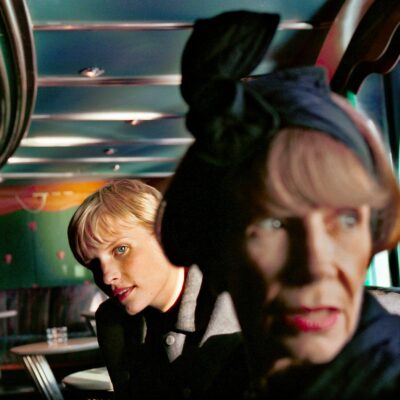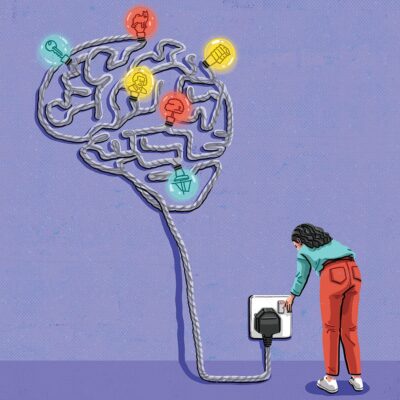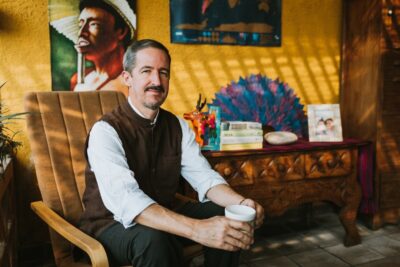 Need to know
Need to know
In February 1969, around 10 in the morning, a young Jorge Luis Borges sat down next to an elderly Jorge Luis Borges on a bench by the Charles River in Cambridge, Massachusetts.
Or so it happened in the Borges short story ‘The Other’. The two Borgeses talk about writing, family and history – while puzzling over how a past self is confronting a future self. At one point, the younger Borges asks the older: ‘How’s your memory?’
‘I realised that for a mere boy not yet 20, a man of 70 some-odd years was practically a corpse,’ Borges wrote.
Outside of fiction, our past and future selves don’t encounter each other so directly. These selves are separated by time, and a future version of you can seem like a distant stranger. But your relationship with that future self could have a big impact on the decisions you make today.
You might think that the one person you can rely on to make decisions in your best interests would be yourself. Yet, people frequently make choices that they later suffer from, in part because the future feels far away. Maybe you’ve woken up after having one too many drinks the night before and thought: ‘Why did I do that?’ The Saturday-night version of you didn’t have the Sunday-morning self in mind. These choices aren’t trivial, or related only to hangovers. They can include not saving enough money for retirement, or not making enough time to exercise, rest, eat well or nurture relationships. What happens in the present catches up to us but, oddly enough, it’s difficult to remember that.
We may think of our future selves as more like strangers
Upon closer examination, it’s not unreasonable to feel detached from your future self. Any number of aspects of your life and physical self might transform over time: where you live, who you spend time with, your job, your hair colour, and even the cells in your body all change as the years pass by.
‘We can be estranged from our future selves,’ says Hal Hershfield, a psychologist at the UCLA Anderson School of Management and the author of Your Future Self: How to Make Tomorrow Better Today (2023). ‘That can help explain why we may prioritise today over the future.’
Many of us actually think of our future selves the way we think of other people. This has been demonstrated experimentally: when people are asked to imagine their own birthdays in the distant future, they do so from a third-person viewpoint; think ahead to your future self blowing out birthday candles, and you’re likely to picture yourself the way you would a character in a film, rather than seeing it through your own eyes. Research led by Emily Pronin at Princeton University has shown that people sometimes make similar decisions for their future selves and for others. For example, they sign up their future selves and other people to drink larger amounts of a disgusting liquid (for a science experiment) than they volunteer their present selves to drink. Studies even suggest that, for some people, parts of the brain activate in similar ways in response to thinking of the future self as they do when thinking of other people – and that this tendency is associated with choosing smaller rewards in the present over waiting for larger rewards in the future.
‘If we think about our future selves as if they are other people, then it makes sense why we sometimes treat them so poorly,’ Hershfield writes in his book. ‘It’s understandable to not diet, save or exercise for those temporally distant strangers, especially when we have this very vivid present self who is hungry and lazy and really wants that new iPhone.’
If you think your future self will be significantly different from who you are today, you are more likely to make choices that honour short-term desires, rather than longer-term needs. After all, if your future self seems barely connected to your current one, what do you owe them? What this means, however, is that getting a better understanding of how you think about your future self – and strengthening your connection to that self – could help you tend to your future health, wellbeing and bank account. In the rest of this Guide, I’ll share some practical approaches, informed by psychologists who study how people relate to future selves, for becoming more aligned to future versions of yourself – and making better choices as a result.
What to do
Focus on what will stay the same
Take a moment to think about your future self, the ‘you’ that lives five, 10 or 20 years into the future. How familiar do they seem? Research has found that people who feel more similar to their future self seem to make decisions that are more future-oriented, such as accumulating greater savings. Daniel Bartels and Oleg Urminsky at the University of Chicago found that, when college students were told that they would still be the same person after graduating, they were more likely to wait to receive a financial reward.
But you don’t have to commit to your future self being virtually identical to your present self in order to feel as though there’s continuity between who you are now and who you will be. Instead, try to home in on what some of the similarities between your present self and your future self might be.
We all expect – and might hope – to change in some ways, such as by developing skills, taking up new hobbies, or forming new relationships. There are likely certain characteristics, however, that you consider more fundamental to your sense of self, such as a particular talent you have or your most valued personal traits. Research on what people consider their ‘true selves’ suggests that one’s morality is typically seen as an essential component of the self.
People also have some characteristics that they consider ‘causally central’, meaning they underlie other events, relationships or situations in their lives. Let’s say Jack and Mack both had few friends as children and spent most of their time alone. Jack may think that this experience caused him to be a shy adult, whereas Mack could believe that it was because he was shy that he had few friends. According to Bartels, this means that ‘shyness will be more defining of Mack’s self-concept than Jack’s because it is causally linked to both his preferences and his memories.’
With all this in mind, think about which elements of your self have had an effect on various other aspects of your life, such as your job, your relationships or your hobbies. Additionally, what do you consider core features of your morality – what are your key values? Reflect on how your most central characteristics and values are likely to persist and show up in your life years or even decades from now. Naming these parts of you – the ones that seem key to your identity – can be helpful for maintaining a connection to the future self that shares those qualities. In ‘The Other’, Borges noticed, with affection, the qualities of his younger self that had remained the same, and that related to the defining passion in his life: ‘We haven’t changed a bit, I thought. Always referring back to books.’
Write a letter to your future self
If you’ve ever written yourself a reminder note or recorded your thoughts in a journal, you have, in a sense, written to your future self. But writing a detailed message to a self who exists even further in the future has been shown to make people feel more connected to that version of themselves.
In Hershfield’s research, people have been prompted to write a letter to their self who lives decades in the future: ‘Think about who you will be 20 years from now, and write about the person you are now, which topics are important and dear to you, and how you see your life.’ After doing so, study participants said it improved their sense of connection to their future self. They even exercised more, in the days after they wrote the letter, than participants who wrote to a version of themselves just three months in the future.
In another study, Anne Wilson, a psychologist at Wilfrid Laurier University in Canada, and her colleagues found that, during the COVID-19 pandemic, people who wrote letters to themselves one year into the future felt a drop in negative emotions.
It might help to direct your letter to your hoped-for or best-possible future self. This connects back to the core values you may have reflected on before – thinking about a best future self that maintains your sense of identity without too much disruption can help you feel more tied to that self.
Wilson has also had study participants write a letter back, from their future self in response to their present self. ‘Thinking about the perspective of the future self was actually more effective than just thinking about it from one perspective alone,’ Wilson says. The dialogue between future and present made the relationship stronger.
During the process of writing a letter, you can also spend time vividly picturing your future self. In a series of studies published in 2011, Hershfield and colleagues used virtual reality to show people digitally created, ‘older’ versions of themselves. In one study, the researchers found that the people who interacted with their virtual future selves were more likely to take a later monetary reward over a smaller immediate one. In a similar experiment, when people saw age-progressed images of themselves, they promised more money to a long-term savings account, compared with those who saw a current picture of themselves. Other experiments showed increased retirement-account contributions after people saw a picture of their older selves.
You could upload a current photo into an ‘ageing’ app, or use a filter that makes you look older. But it may be enough to simply imagine yourself as older, to envision the facial features that might remain similar over time and, importantly, to keep in mind that your future self ‘is a living, breathing individual who is dependent on the choices of the current self’, as Hershfield says.
Redraw, or erase, the boundary line between the present and the future
The American psychologist William James called the present moment the ‘specious present’, arguing that there was no such thing as ‘right now’ – it’s a subjective experience. So, when do you feel like the present ends? This is a question that Hershfield and his colleague Sam J Maglio have asked study participants. Five years is far enough away that it probably seems like ‘the future’, but what about five seconds from now? Five minutes? Five days?
People vary on when they think the present ends and the future begins – and, according to Hershfield, those who generally believe that the future starts sooner rather than later are more likely to make future-oriented choices. When people believe the present moment lasts longer, they feel less emotion about the future. But if the future seems closer, or if the start of the future seems closer, then there may be more motivation to ensure that the self on the other side of the present/future border is taken care of.
It could be helpful to think less rigidly about the boundaries between the present and the future, to blur the lines between the you that exists now and the one that has yet to be. In their study, Hershfield and Maglio used messaging that emphasised that the future was imminent in advertising a financial wellbeing course. One flyer said: ‘The present is short and the future starts sooner: acquire better financial habits today!’ (while a contrasting one said: ‘The present is long and the future starts later: acquire better financial habits today!’) Students who were exposed to the notion that the future was starting soon were more eager to sign up.
It may take some simple reminders of this sort to feel more tethered to the future. Hershfield has suggested an ‘elevated perspective’ on time: instead of dwelling only in the present, with the future far off, consider that ‘the past, present, and future are equally visible and subjectively relevant.’ Thinking about time in this way could help you appreciate the present moment while also recognising that the future is closer than it might seem, and intimately tied to the present. Like Annie Dillard put it in The Writing Life (1989): ‘How we spend our days is, of course, how we spend our lives.’
Think of your future self as a close loved one
In L A Paul’s book, Transformative Experience (2014), she argues that we simply can’t know what it’s like to live through certain moments until we experience them. You can try to imagine or anticipate what it might be like to have a child, say, or to live in a new place – but there’s a pool of knowledge that you can’t access until you’ve undergone the transformation and really lived it.
‘It can be hard to project ourselves into the future and really imagine: what is the right decision to make for this future self, down the road?’ Wilson says. The future is, by definition, hypothetical, she says. You should try to feel more connected to your future self. But also, there could be some version of your future self that’s just always going to be unknowable until you arrive at it.
To help you allow for these unknowns, you can try to think of your future self as you would a close loved one, such as a child, spouse or parent. You can’t know everything about them, and you expect them to change over time in ways you can’t control, but you’re still committed to that person. You can care about and feel a sense of responsibility and duty towards your future self in the way you care about those closest to you.
‘The reality is that they change and we change over time, too,’ Hershfield says. ‘And in the best relationships, we’re still committed to them.’ He advises us to ‘own the fact that we can never truly know our future selves’, but notes that ‘it would be irrational to not try to plan in some way.’
We do eventually turn into our future selves, which makes the relationship unlike any other. One day, you will wake up and be your future self. In a sense, you do this every day – becoming the self of tomorrow, from yesterday’s perspective. This perpetual becoming could make it the closest relationship you have to foster. When he met his past self, Borges wrote: ‘I, who have never been a father, felt a wave of love for that poor young man who was dearer to me than a child of my own flesh and blood.’
Original article here












 I believe this with every fibre of my being and I live it, in myself and witnessing it in others, in every way I can. So what are some of these super powers that we’re seeing these days? I’ll try to encapsulate a few of the ones I’m aware of.
I believe this with every fibre of my being and I live it, in myself and witnessing it in others, in every way I can. So what are some of these super powers that we’re seeing these days? I’ll try to encapsulate a few of the ones I’m aware of.



 Dr. James McGaugh remembers that day too. At the time, he was director of UC Irvine’s Center for the Neurobiology of Learning and Memory, the research institute that he founded in 1983. In her email, Jill Price said that she had a problem with her memory. McGaugh responded almost immediately, explaining that he worked at a research institute and not a clinic, and that he’d be happy to direct her to somewhere she could find help.
Dr. James McGaugh remembers that day too. At the time, he was director of UC Irvine’s Center for the Neurobiology of Learning and Memory, the research institute that he founded in 1983. In her email, Jill Price said that she had a problem with her memory. McGaugh responded almost immediately, explaining that he worked at a research institute and not a clinic, and that he’d be happy to direct her to somewhere she could find help. Still, he started from a position of scepticism. “In interrogating her, I started with the scientific assumption that she couldn’t do it,” he told me. And even though Price showed that she could, repeatedly, McGaugh was still unmoved. “Yeah, it got my attention, but I didn’t say, ‘Wow.’ We had to do a lot more. So we did a lot more.” (In Price’s recollection, however, her ability to remember “really freaked Dr McGaugh out.”)
Still, he started from a position of scepticism. “In interrogating her, I started with the scientific assumption that she couldn’t do it,” he told me. And even though Price showed that she could, repeatedly, McGaugh was still unmoved. “Yeah, it got my attention, but I didn’t say, ‘Wow.’ We had to do a lot more. So we did a lot more.” (In Price’s recollection, however, her ability to remember “really freaked Dr McGaugh out.”) In May 2012, the journal Neurobiology of Learning and Memory published a follow-up study by UCI neuroscience graduate student Aurora LePort and neurobiologist Dr Craig Stark, then the director of the UCI Center for the Neurobiology of Learning and Memory. It was now nearly 12 years since Price first reached out to McGaugh, but researchers were only fractionally closer to finding the answer she was looking for.
In May 2012, the journal Neurobiology of Learning and Memory published a follow-up study by UCI neuroscience graduate student Aurora LePort and neurobiologist Dr Craig Stark, then the director of the UCI Center for the Neurobiology of Learning and Memory. It was now nearly 12 years since Price first reached out to McGaugh, but researchers were only fractionally closer to finding the answer she was looking for. For both Price and Petrella, there is a specific point in their lives that they feel triggered their ability to remember things with extraordinary clarity. For Petrella, it was when he was seven years old and playing a deliriously fun game in his backyard with a childhood friend. The next day, Petrella invited his friend over to play it again, but they only played for a few minutes before getting bored. Petrella realised then that nothing ever stays the same and that it was important that he remember things before they changed. For Price, it was her family’s traumatic move to the West coast. In each case, Price and Petrella say they already had strong memories before this decisive moment, but after it, their ability to remember was transformed.
For both Price and Petrella, there is a specific point in their lives that they feel triggered their ability to remember things with extraordinary clarity. For Petrella, it was when he was seven years old and playing a deliriously fun game in his backyard with a childhood friend. The next day, Petrella invited his friend over to play it again, but they only played for a few minutes before getting bored. Petrella realised then that nothing ever stays the same and that it was important that he remember things before they changed. For Price, it was her family’s traumatic move to the West coast. In each case, Price and Petrella say they already had strong memories before this decisive moment, but after it, their ability to remember was transformed.
 I love my family. I was brought up in a very close family. Of course we fight, but we also laugh together. We share everything — all the joys and the pains. And I know the pain I am feeling, my family will feel the same thing. We confide in each other and find comfort in that. When I want to be happy, my family is always there for me.
I love my family. I was brought up in a very close family. Of course we fight, but we also laugh together. We share everything — all the joys and the pains. And I know the pain I am feeling, my family will feel the same thing. We confide in each other and find comfort in that. When I want to be happy, my family is always there for me. I’ve been working in rural areas for the last ten years. And in the women, peasants and farmers I’ve met there, I’ve found another kind of genius. They help me understand that the future is possible.
I’ve been working in rural areas for the last ten years. And in the women, peasants and farmers I’ve met there, I’ve found another kind of genius. They help me understand that the future is possible.



 It’s common to wonder whether talking to yourself is “normal.” Let me be the first to tell you—it’s what got me through the pandemic.
It’s common to wonder whether talking to yourself is “normal.” Let me be the first to tell you—it’s what got me through the pandemic. At first, I was reluctant. I asked my body audibly, “How are you feeling?” when my migraines worsened. Often, my body would flood with anxiety or freeze up with stress. When that happened, I’d ask, “What do you need in order to feel more relaxed?” I would wait and listen, then act on what my body “said” back to me. If my body felt tired, I would nap. If I was anxious, I would meditate. If I needed more information about what my body needed, I asked follow-up questions.
At first, I was reluctant. I asked my body audibly, “How are you feeling?” when my migraines worsened. Often, my body would flood with anxiety or freeze up with stress. When that happened, I’d ask, “What do you need in order to feel more relaxed?” I would wait and listen, then act on what my body “said” back to me. If my body felt tired, I would nap. If I was anxious, I would meditate. If I needed more information about what my body needed, I asked follow-up questions.